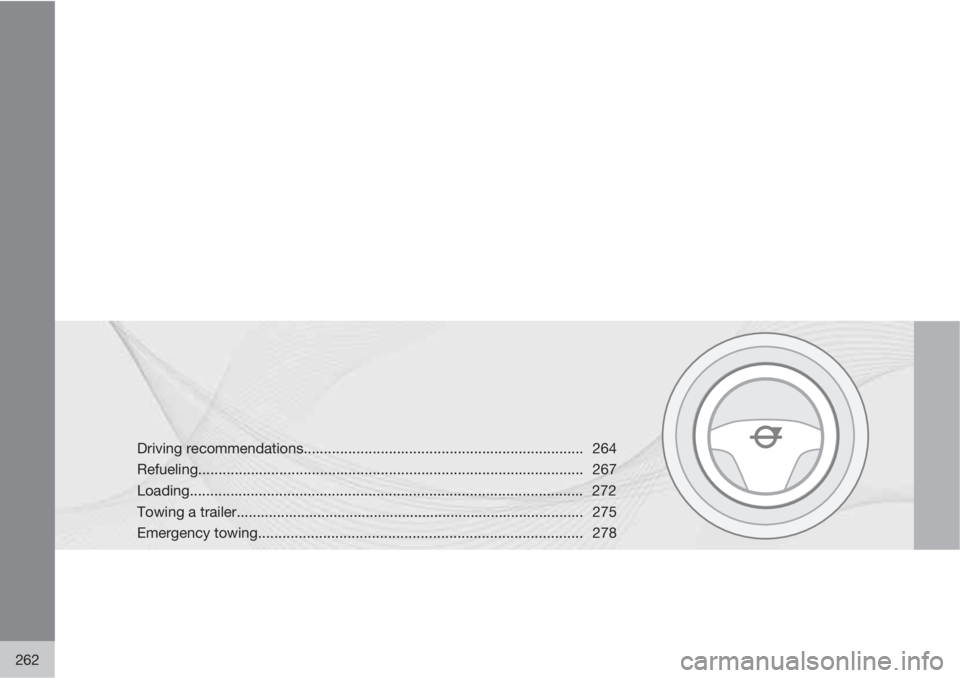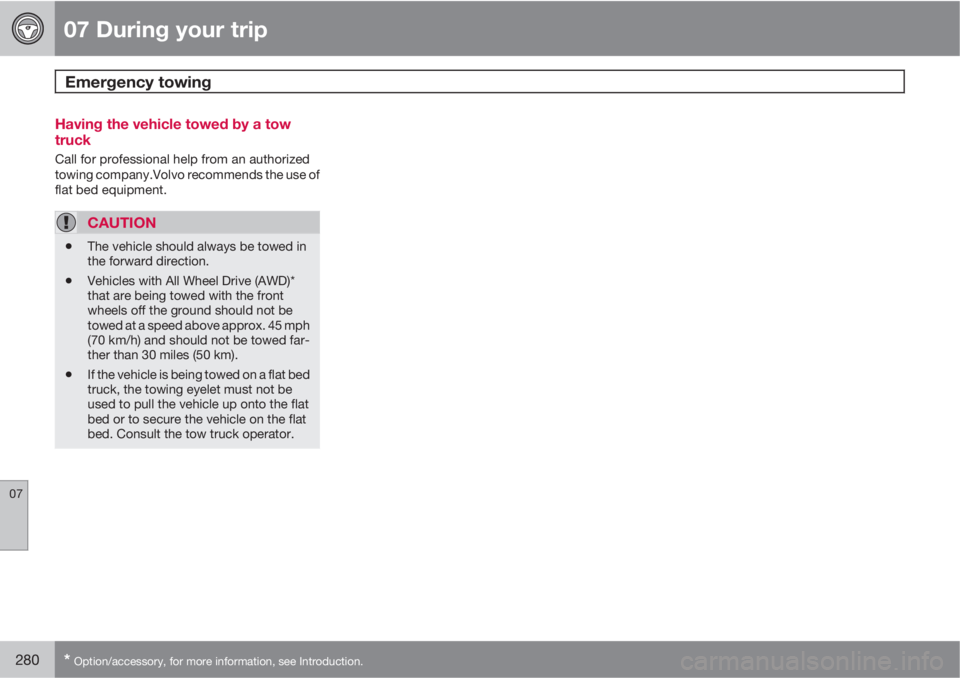2013 VOLVO S80 emergency towing
[x] Cancel search: emergency towingPage 6 of 372

Contents
4* Option/accessory, for more information, see Introduction.
06
06 Infotainment
Introduction............................................. 210
Radio....................................................... 221
Media player........................................... 230
AUX/USB sockets................................... 234
Bluetooth
�Ÿ media ................................... 237
Bluetooth® hands-free connection ........ 239
Cell phone voice control......................... 247
Rear Seat Entertainment (RSE)* .............251
Remote control*...................................... 260
07
07 During your trip
Driving recommendations....................... 264
Refueling................................................. 267
Loading................................................... 272
Towing a trailer....................................... 275
Emergency towing.................................. 278
08
08 Wheels and tires
General information ...............................284
Tire inflation............................................. 287
Inflation pressure ...................................289
Tire designations .................................... 290
Glossary of tire terminology ................... 292
Vehicle loading ....................................... 293
Uniform Tire Quality Grading ................. 295
Snow chains, snow tires, studded tires . 296
Temporary Spare ................................... 297
Tire Sealing System................................ 298
Changing a wheel ..................................304
Tire Pressure Monitoring System (TPMS) 307
Page 85 of 372

03 Your driving environment
Ignition modes
03
83 Ignition modes
Ignition mode 0–The vehicle is unlocked.
Ignition mode I–With the remote key fully pressed into the
ignition slot1, press START/STOP
ENGINE briefly.
Ignition mode II–With the remote key fully pressed into the
ignition slot1, press START/STOP
ENGINE for approximately 2 seconds.
Returning to mode 0To return to mode 0 from mode II or I, press
START/STOP ENGINE briefly.
Starting and stopping the engine
See page 111 for information on starting the
engine and switching it off.
Emergency towing
See page 279 for important information about
the remote key when the vehicle is being
towed.
1Not necessary in vehicles with the optional keyless drive.
Page 122 of 372

03 Your driving environment
Brakes
03
120
•The ABS system activates for more than
approximately a half second
•In the event of sudden braking while the
vehicle is moving at speeds above approx-
imately 6 mph (10 km/h)
When the vehicle has come to a stop, the brake
lights and additional taillights remain on for as
long as the brake pedal is depressed or until
braking force on the vehicle is reduced.
Power brakes function only when the
engine is running
The power brakes utilize vacuum pressure
which is only created when the engine is run-
ning. Never let the vehicle roll to a stop with the
engine switched off.
If the power brakes are not working, consider-
ably higher pressure will be required on the
brake pedal to compensate for the lack of
power assistance. This can happen for exam-
ple when towing your vehicle or if the engine is
switched off when the vehicle is rolling. The
brake pedal feels harder than usual.
Water on brake discs and brake pads
affects braking
Driving in rain and slush or passing through an
automatic car wash can cause water to collect
on the brake discs and pads. This will cause a
delay in braking effect when the pedal is
depressed. To avoid such a delay when thebrakes are needed, depress the pedal occa-
sionally when driving through rain, slush, etc.
This will remove the water from the brakes.
Check that brake application feels normal. This
should also be done after washing or starting
in very damp or cold weather.
Severe strain on the brake systemThe brakes will be subject to severe strain
when driving in mountains or hilly areas, or
when towing a trailer. Vehicle speed is usually
slower, which means that the cooling of the
brakes is less efficient than when driving on
level roads. To reduce the strain on the brakes,
shift into a lower gear and let the engine help
with the braking. Do not forget that if you are
towing a trailer, the brakes will be subjected to
a greater than normal load.
Anti-lock braking system (ABS)The Anti-lock Braking System (ABS) helps to
improve vehicle control (stopping and steering)
during severe braking conditions by limiting
brake lockup. When the system "senses"
impending lockup, braking pressure is auto-
matically modulated in order to help prevent
lockup that could lead to a skid.
The system performs a brief self-diagnostic
test when the engine has been started and
driver releases the brake pedal. Another auto-
matic test may be performed when the vehicle
first reaches a speed of approximately 6 mph(10 km/h). The brake pedal will pulsate several
times and a sound may be audible from the
ABS control module, which is normal.
Cleaning the brake discsCoatings of dirt and water on the brake discs
may result in delayed brake function. This delay
is minimized by cleaning the brake linings.
Cleaning the brake pads is advisable in wet
weather, prior to long-term parking, and after
the vehicle has been washed. Do this by brak-
ing gently for a short period while the vehicle is
moving.
Emergency Brake AssistanceEBA is designed to provide full brake effect
immediately in the event of sudden, hard brak-
ing. The system is activated by the speed with
which the brake pedal is depressed.
When the EBA system is activated, the brake
pedal will go down and pressure in the brake
system immediately increases to the maximum
level. Maintain full pressure on the brake pedal
in order to utilize the system completely. EBA
is automatically deactivated when the brake
pedal is released.
Page 264 of 372

262
Driving recommendations..................................................................... 264
Refueling............................................................................................... 267
Loading................................................................................................. 272
Towing a trailer...................................................................................... 275
Emergency towing................................................................................ 278
Page 280 of 372

07 During your trip
Emergency towing
07
278
Towing eyelet
G021500
Attaching the towing eyelet
Attaching the towing eyeletThe towing eyelet is located under the floor
of the trunk, with the spare tire. This eyelet
must be screwed into the positions provi-
ded on the right sides of either the front or
rear bumper (see illustration).
There are two different types of covers over
the openings for the towing eyelet and they
have to be opened differently.
•If the cover has a notch, insert a coin,
etc., into the notch and pry open the
edge of the cover. Open the cover com-
pletely and remove it.
•If the cover has a mark along one edge
or in a corner, press the mark while pry-
ing out the opposite side/corner using a
coin, etc. Open the cover and remove it.
Screw the towing eyelet in place, first by hand
and then using the tire iron until it is securely in
place.
After the vehicle has been towed, the eyelet
should be removed and returned to its storage
location.
Press the cover for the attachment point back
into position.
NOTE
On certain models equipped with a trailer
hitch, the towing eyelet cannot be screwed
into the hole in the rear bumper. The towing
rope should be attached to the trailer hitch
instead. For this reason, the detachable
section of the trailer hitch should be safely
stowed in the vehicle at all times.
Page 281 of 372

07 During your trip
Emergency towing
07
279
WARNING
•When the vehicle is being towed, the
ignition should be in mode II (in mode I,
all of the vehicle's airbags are deacti-
vated). See page 83 for more informa-
tion about ignition modes.
•Never remove the remote key from the
ignition slot when the vehicle is being
towed. For vehicles with keyless drive,
the remote key must remain inside the
vehicle.
•The power brakes and power steering
will not function when the engine is not
running. Approximately 5 times more
pressure will be required on the brake
pedal and the steering wheel will be
considerably harder to turn.
•The towing eyelets must not be used for
pulling the vehicle out of a ditch or for
any similar purpose involving severe
strain. Do not use the towing eyelets to
pull the vehicle up onto a flat bed tow
truck.
Towing the vehicle
1. With the remote key fully pressed into the
ignition slot1, press START/STOP
ENGINE for approximately 2 seconds to
activate ignition mode II.
2. The remote key must remain in the ignition
slot
2 for the entire time that the vehicle is
being towed.
3. Keep the tow rope taut when the towing
vehicle slows down by applying light pres-
sure on the brake pedal. This will help pre-
vent jarring movements of the vehicle
being towed.
4. Be prepared to apply the brakes to stop the
vehicle being towed.
CAUTION
General towing precautions:
•Please check with state and local
authorities before attempting this type
of towing, as vehicles being towed are
subject to regulations regarding maxi-
mum towing speed, length and type of
towing device, lighting, etc.
•If the vehicle's battery is dead, attach
jumper cables (see page 114) to provide
current for releasing the electric parking
brake and to move the gear selector
from the P position to N. If this is not
possible, see page 118 for information
about manually overriding the shiftlock
system to move the gear selector from
P to N.
•Maximum speed: 50 mph (80 km/h). Do
not exceed the maximum allowable
towing speed.
•Maximum distance with front wheels on
ground: 50 miles (80 km).
•The vehicle should only be towed in the
forward direction.
1Not necessary in vehicles with the optional keyless drive.2For vehicles with the the optional keyless dirive, the remote key must be in the vehicle.
Page 282 of 372

07 During your trip
Emergency towing
07
280* Option/accessory, for more information, see Introduction.
Having the vehicle towed by a tow
truck
Call for professional help from an authorized
towing company.Volvo recommends the use of
flat bed equipment.
CAUTION
•The vehicle should always be towed in
the forward direction.
•Vehicles with All Wheel Drive (AWD)*
that are being towed with the front
wheels off the ground should not be
towed at a speed above approx. 45 mph
(70 km/h) and should not be towed far-
ther than 30 miles (50 km).
•If the vehicle is being towed on a flat bed
truck, the towing eyelet must not be
used to pull the vehicle up onto the flat
bed or to secure the vehicle on the flat
bed. Consult the tow truck operator.
Page 364 of 372

11 Index
11
362
E
ECC.........................................194, 196, 197
Economical driving.................................. 264
Electric parking brake.............................. 122
Electronic Climate Control.......194, 196, 197
air distribution table............................ 198
Interior Air Quality System.................. 197
ventilated seats................................... 194
Emergency locking retractor...................... 37
Emergency starting.................................. 114
Emergency towing................................... 278
Emission inspection readiness................ 313
Engine
overheating........................................... 79
specifications...................................... 352
starting................................................ 111
switching off....................................... 114
Engine compartment overview................315
Engine oil................................................. 353
checking............................................. 316
low pressure warning light.............. 77, 78
volumes.............................................. 354
Engine remote start (ERS)........................ 113
Environment............................................... 12Eyelets for anchoring loads..................... 272
F
Federal Clean Air Act............................... 312
Flat tires
repairing with tire sealing system....... 298
Floor mats
cleaning.............................................. 343
placing correctly................................. 111
Fluid specifications.................................. 354
Fog lights
front/rear......................................... 95, 96
Four C (active chassis system)................202
Front airbags.............................................. 22
disconnecting passenger’s side air-
bag.................................................. 26, 27
Front fog lights........................................... 95
Front park assist..............................168, 170
Front seats...........................................84, 86
heated................................................. 194
Fuel filler cap........................................... 270
Fuel filler door, opening........................... 269
Fuel level warning light.............................. 77Fuel requirements............................ 267, 268
Fuel tank volume.....................................354
Fuses............................... 332, 333, 336, 339G
Garage door opener
HomeLink® Wireless Control System. 108
Gasoline requirements............................. 268
Gas tank volume...................................... 354
Gauges...................................................... 75
Geartronic................................................ 117
Geartronic automatic transmission.......... 117
Generator warning light............................. 78
Glossary of tire terminology..................... 292
Grocery bag holder.................................. 273
Gross vehicle weight...............................293
H
Hazard warning flashers............................ 96
HD digital radio........................................ 223